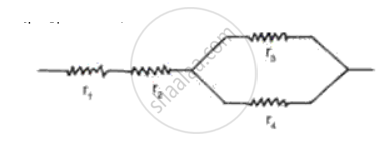Advertisements
Advertisements
Question
The resistance of two resistors joined in series is 8Ω and in parallel is 1.5Ω. Find the value of the two resistances.
Solution
In series, R1 + R2 = 8 Ω
In parallel `("R"_1"R"_2)/("R"_1 + "R"_2) = 1.5` Ω
∴ R1R2 = 8 × 1.5 = 12 Ω
Now (R1 - R2)2 = (R1 + R2)2 - 4R1R2
∴ (R1 - R2)2 = (8)2 - 4 × 12
or (R1 - R2)2 = 64 - 48 = 16
or R1 - R2 = 4 Ω
On solving equations (i) and (ii) R1 = 6 Ω and R2 = 2 Ω
APPEARS IN
RELATED QUESTIONS
Find the expression for resistors connected in series.
(i) Two sets A and B, of three bulbs each, are glowing in two separate rooms. When one of the bulbs in set A is fused, the other two bulbs also cease to glow. But in set B, when one bulb fuses, the other two bulbs continue to glow. Explain why this phenomenon occurs.
(ii) Why do we prefer arrangements of Set B for house circuiting?
Calculate the resistance of an aluminium cable of length 10 km and diameter 2.0 mm if the resistivity of aluminium is 27 × 10−8 Ωm.
V = IRTwo resistances X and Y are connected turn by turn : (i) in parallel, and (ii) series. In which case the resultant resistance will be less than either of the individual resistances?R = R1+ R2+ R3
State the order of resistivity of (i) a metal, (ii) a semiconductor and (iii) an insulator.
What potential difference is needed to drive a current o f 1 A through a 5 Ω resistor?
Calculate the equivalent resistance of the following combination of resistor r1, r2, r3, and r4

State the effect of rise in temperature on the resistance of semi-conductors.
Calculate the quantity of heat that will be produced in a coil of resistance 75 Ω if a current of 2A is passed through it for 2 minutes.
